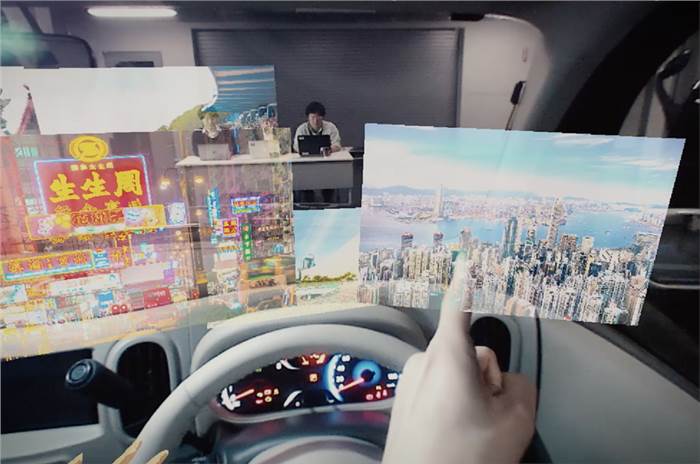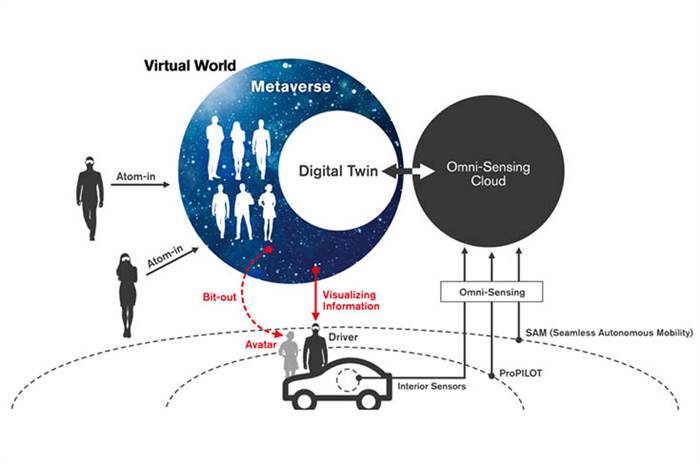At the ongoing CES 2019 trade show at the Las Vegas Convention Center, Nissan has taken the wraps off its i2V technology – the carmaker's futuristic vision for a vehicle that merges both real and virtual worlds; helping drivers ‘see the invisible’ and creating the ultimate connected-car experience. This real-time data is projected to the car's windshield.
i2V (which stands for "Invisible to Visible") merges information from sensors outside and inside the vehicle with cloud data enabling the system to not only track the vehicle's immediate surroundings but also to anticipate what lies ahead – and even show the driver what's behind a building or around the corner. To make driving more enjoyable, guidance is given in an interactive, human-like way, like virtual avatars.
i2V taps into the virtual world to open up endless possibilities for service and communication, so as to make driving more convenient, comfortable and exciting. "By helping you see the invisible, i2V enhances your confidence and makes driving more enjoyable," said Tetsuro Ueda, an expert leader at the Nissan Research Center. "The interactive features create an experience that's tailored to your interests and driving style so that anyone can enjoy using it in their own way."
INTO THE METAVERSE
i2V is powered by Nissan's Omni-Sensing technology, which acts as a hub – gathering real-time data from the traffic environment and from the vehicle's surroundings and interior. Nissan's SAM (Seamless Autonomous Mobility) technology analyses the road environment through relevant real-time information, and the ProPILOT semi-autonomous driver support system provides information about the car's surroundings.
The technology maps a 360-degree virtual space around the car to provide information about things like the road and intersection status, visibility, road signs and nearby pedestrians. It can also monitor the people inside the vehicle using interior sensors, so as to better anticipate when they may need assistance with finding something or if they need a coffee break to stay alert.
i2V can also connect drivers and passengers to the Metaverse – which encompasses the virtual world, augmented reality and the internet. This makes it possible for family, friends or others to appear inside the car as three-dimensional, augmented-reality avatars to provide company or assistance.
MORE AUTONOMOUS AND MANUAL DRIVING SUPPORT
During autonomous driving, Nissan says that i2V can make time spent in a car more comfortable and enjoyable. When driving in the rain, for instance, the scenery of a sunny day can be projected inside the vehicle.
When visiting a new place, the system can search the Metaverse for a knowledgeable local guide who can communicate with people in the vehicle in real time.
Information provided by the guide can be collected with Omni Sensors and stored in the data cloud so that others visiting the same area can access the same information. It can also be used by the on-board artificial-intelligence system to drive more efficiently through areas.
During manual driving, i2V technology uses information provided by its Omni Sensors as an overlay in the driver's full field of view. The information helps drivers assess and prepare for things like corners with poor visibility, irregular road-surface conditions or oncoming traffic.
The driver can also use the Metaverse access to book a professional driver and get personal instruction in real time. The professional driver appears either as a projected avatar or as a virtual chase car in the driver's field of vision and demonstrates the best way to drive.
Not only will i2V display information about congestion and estimated travel time; it can also communicate unique details to better inform the driver about the road ahead, removing unknowns to ease driving stress. i2V will give alternative suggestions, down to the best-moving lane in heavy traffic, by using real-time local data-mapping via Omni-Sensing.
Upon arrival at a destination, i2V can access SAM to scan for parking spaces and park the vehicle for the driver in situations that require difficult or tricky parking manoeuvres.
Also see:
Nissan Kicks to launch on January 22
Hyundai Elevate ‘walking car’ concept previewed










Comments
Member Login
Personal Details
No comments yet. Be the first to comment.